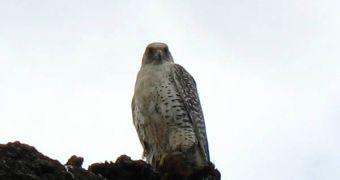In some of the most remote areas of the world, finding a suitable nesting place can be a real problem. That's why some birds don't even bother going through all that hassle, and remain in the regions around which they grow up. They take care of their young in the same nests that their parents used to rear them, and, so, the places remain occupied for years, sometimes for thousands of years, as a new find made in Greenland shows. Experts analyzed the nest and determined that it was over 2,500 years old and that, most likely, it had been continuously used since before the time of the Roman Empire.
The nest, which was positively identified as the oldest in the world, is located in the same region as three others, estimated to be more than 1,000 years old each. According to experts, gyrfalcons have used these nesting grounds generation after generation, but climate change may soon drive them away.
The bird, which is the largest species of falcons in the world, only lives circumpolar to the Arctic regions, the BBC News informs. The species lives in small numbers in Greenland and Canada, as well as in the Labrador peninsula, on the western banks of the North Atlantic.
Despite its impressive size, the gyrfalcon is no exception from one of the traits that define falcons – the inability (or laziness) to build their own nests from twigs and other parts. They usually “squat” an existing nest, built by a raven or other larger bird, or lay their eggs in the cavities carved on the edge of cliffs, near the ocean.
These ledges and potholes have the advantage of not succumbing to the forces of nature over the years, like twig nests do, so they are often visited year after year. Knowing this, University of Oxford Ornithologist Kurt Burnham brought together a team of colleagues, and set out to analyze the guano and feather remains in several nests in Greenland.
In some of these locations, the level of accumulated guano exceeds two meters (roughly six to seven feet), and the climate of the region allowed for it to be preserved to some extent. The oldest nest in the world was found in the central-western part of the island, in Kangerlussua. Carbon dating has shown that it is between 2,360 and 2,740 years old, while the most recent one found is between 520 and 650 years old. “While I know many falcon species re-use nest sites year after year, I never imagined we would be talking about nests that have been used on and off for over 2,000 years,” Burnham told the news outlet.
“These findings put new emphasis on just how important nest site characteristics can be for raptor species, particularly large raptors. Something, be it nest ledge depth, or the amount of cliff overhang above the nest, is so attractive at these locations that gyrfalcons are re-using them for thousands of years,” the expert added.

 14 DAY TRIAL //
14 DAY TRIAL //